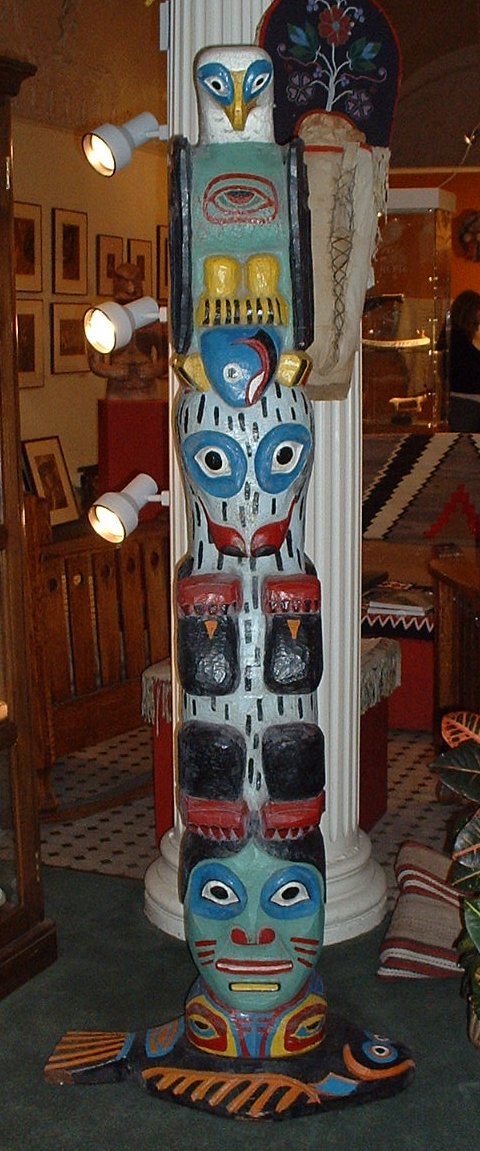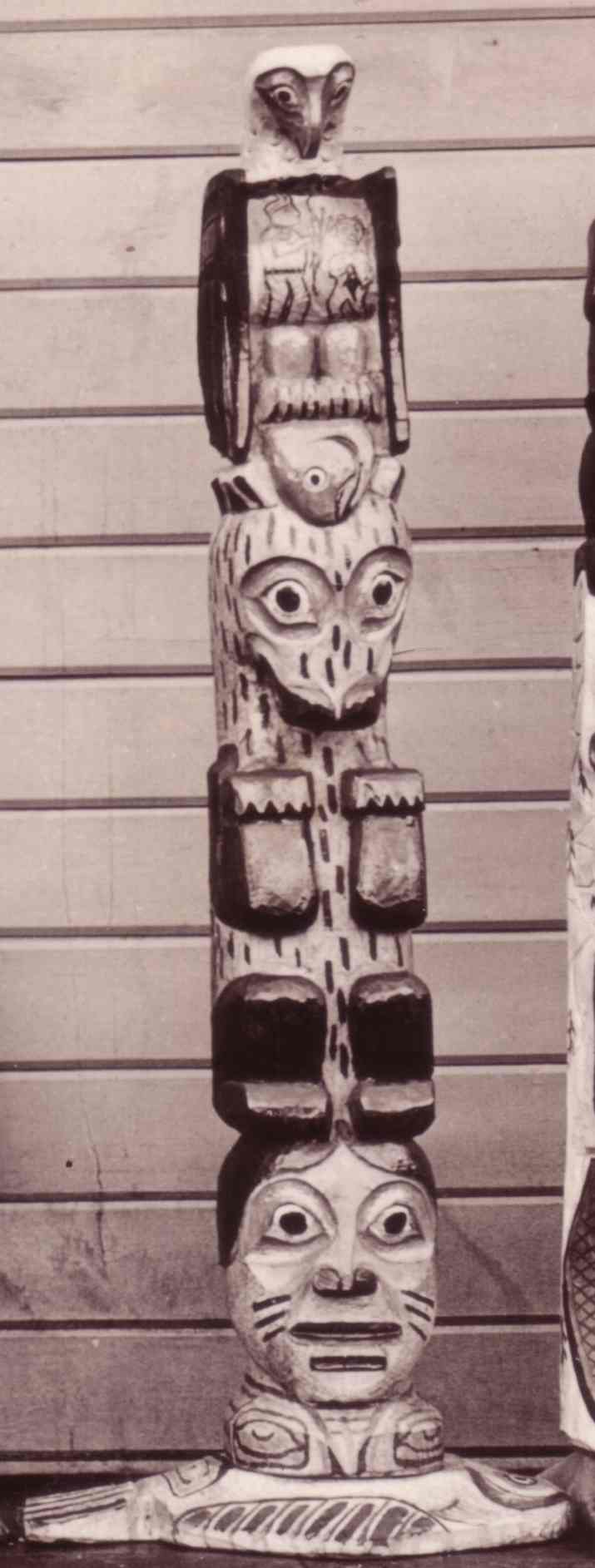...and now |
The story is on the back of a big pole by Casper Mather, now at Flury and Co. in Seattle; though unsigned, we see the same pole pictured with Mather in a postcard, (1910-1920?). The story on the back, probably in Mather's hand, refers to the pole as the Little Eagle Totem; the smaller pole pictured below carries both names; and "Good Luck Totem" is written on the back of Tait's small eagle-salmon-bear poles. The story is in fact a Tshimsian legend called "Little Eagle;" and according to Viola Garfield (The Wolf and the Raven, p.42) it is "localized around Port Simpson." Significantly, many of the early Metlakatla carvers came from this area; and it indicates that the story came from Canada with them, rather than being found in the new country. The pole thus reflects an actual knowledge of legends and crests, rather than just being an invented souvenir item. The story is now known among the Tlingit by intermarriage, and one wonders if that is due to the Metlakala migration. |
In an important new discovery, a totem pole pictured in an old postcard has re-appeared; and a paper stapled to the back has revealed the "story" of the Good Luck totems. We now know the rest of the story that Eli Tait told to the traveler in 1939: "He told us the story about this boy...... and we can guess a little more about the possible origins of the totem. We even know the boy's name. In a second discovery, the story has been confirmed by a label on a smaller pole. |
The Story Discovered |
In an important new discovery, a totem pole pictured in an old postcard has re-appeared; and a paper stapled to the back has revealed the "story" of the Good Luck totems. We now know the rest of the story that Eli Tait told to the traveler in 1939: "He told us the story about this boy...... and we can guess a little more about the possible origins of the totem. We even know the boy's name. In a second discovery, the story has been confirmed by a label on a smaller pole. |
The story is on the back of a big pole by Casper Mather, now at Flury and Co. in Seattle; though unsigned, we see the same pole pictured with Mather in a postcard, (1910-1920?). The story on the back, probably in Mather's hand, refers to the pole as the Little Eagle Totem; the smaller pole pictured below carries both names; and "Good Luck Totem" is written on the back of Tait's small eagle-salmon-bear poles. The story is in fact a Tshimsian legend called "Little Eagle;" and according to Viola Garfield (The Wolf and the Raven, p.42) it is "localized around Port Simpson." Significantly, many of the early Metlakatla carvers came from this area; and it indicates that the story came from Canada with them, rather than being found in the new country. The pole thus reflects an actual knowledge of legends and crests, rather than just being an invented souvenir item. The story is now known among the Tlingit by intermarriage, and one wonders if that is due to the Metlakala migration. |

"This is known as Little Eagle Totem Once there was an Indian village beween the Nass and the Skeena River, and there was a Chief in this village who had a nephew who was going to take his place...." When he was supposed to be drying fish for the winter, the nephew instead fed the fish to eagles on the beach, leading to fears that the people would go hungry in the winter, which in fact happened. However, the eagles brought food for the people, salmon and halibut, and the warehouses were filled. Thus the boy became chief, and the eagle became the family crest. The old chief was of the bear clan.... |

...and now |


Close-ups of the face on the postcard and on the pole as it appears now show that the blue paint and stippling on the bear have survived the years, although the halibut, eye sockets, the eagles chest, and the human faces have been repainted. Restoration is underway. |


the pole then... |
This 24" pole by George Mather Sr was carved circa 1960-1970; it bears a number of similarities to the work of Clyde Boyd. It carries an informative document, giving "Little Eagle" and "Good Luck" as alternative names for the pole, and referring to the story as one of crest-acquisition amongst the Tsimpsean. It is also interesting that it mentions both the versions carved with the boy, and those without; and names the boy: Little Eagle himself. Note the unusually large eyes on the bear (Totem identified by C.S.) |


Note the remark about totems being counterfeited by outside manufacturers......in the early 1960's.... |
"The Little Eagle or "Good Luck" pole shows an eagle surmounting a bear. Sometimes the chief's son, Little Eagle, is also carved at the base. The pole tells the story of the acquisition of the eagle as a crest by the Bear Family of the Tsimpseans. During the salmon run, the chief's young son left all his fish for the eagles, so that he might have their feathers for his arrows. When starvation threatened and the people moved, his father deserted him, saying "He fed the eagles, now let the eagles feed him." The eagles brought him great quantities of fish, seal, and whales. He was able to lay up huge stores of food, and thus became a great and powerful chief." |